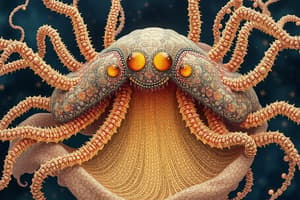Podcast
Questions and Answers
What are the defining characteristics of ctenophores? (Select all that apply)
What are the defining characteristics of ctenophores? (Select all that apply)
- Rows of fused cilia (correct)
- Endoderm + ectoderm = 2 layers of living tissue (correct)
- Colloblasts (correct)
- Freshwater habitat
What is the class and order of Ctenophora that has 4 costae and short tentacles?
What is the class and order of Ctenophora that has 4 costae and short tentacles?
Class Tentaculata, Order Lobata
What is a defining feature of Class Tentaculata, Order Cydippida?
What is a defining feature of Class Tentaculata, Order Cydippida?
Longass retractable tentacles for food capture
What distinguishes Class Tentaculata, Order Cestida?
What distinguishes Class Tentaculata, Order Cestida?
What are the characteristics of Class Nuda, Order Beroida?
What are the characteristics of Class Nuda, Order Beroida?
What are colloblasts?
What are colloblasts?
What is the function of a statolith in ctenophores?
What is the function of a statolith in ctenophores?
Study Notes
Ctenophora Overview
- Belongs to the phylum Ctenophora, commonly known as comb jellies.
- Recognized for unique anatomical features including colloblasts and ctenes.
Class Tentaculata, Order Lobata
- Characterized by having 4 costae (longitudinal stripes).
- Possess short tentacles and large oral lobes for feeding.
Class Tentaculata, Order Cydippida
- Notable for long, retractable tentacles utilized primarily for capturing prey.
Class Tentaculata, Order Cestida
- Features a flat, ribbon-like shape.
- Equipped with short tentacles positioned along the edge.
Class Nuda, Order Beroida
- Identified by 8 costae and lack of tentacles on oral lobes.
- Body shapes vary from almond to long football and stumpy banana.
Defining Characteristics of Ctenophores
- Have specialized cells called colloblasts important for catching prey.
- Exclusively found in marine environments.
- Possess rows of fused cilia known as ctenes, which aid in locomotion.
- Body structure includes two layers of living tissue: endoderm and ectoderm.
- Contains a gelatinous layer called mesoglea between the tissue layers.
Colloblasts
- Cells that cover the outer layer of tentacles.
- Play a critical role in the capture of prey through adhesive properties.
Statolith
- An apical sense organ that helps in orientation.
- Controls the movement of cilia for swimming and stabilization.
Studying That Suits You
Use AI to generate personalized quizzes and flashcards to suit your learning preferences.
Description
Explore the fascinating phylum Ctenophora, also known as comb jellies. This quiz covers various classes and orders within Ctenophora, highlighting their unique anatomical features, feeding mechanisms, and environmental habitats. Test your knowledge on the distinct characteristics of these marine creatures.




